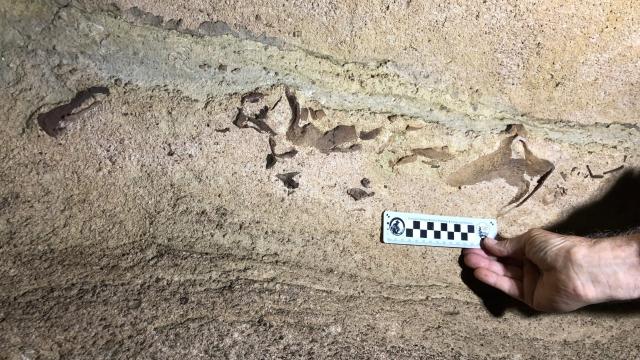Sharks typically don’t come to mind when you think about landlocked Kentucky, but as fossil evidence from the state’s Mammoth Cave National Park shows, this place was once chock-full of the carnivorous fishes.
Paleontologists working at the national park uncovered fossils from around 150 sharks representing as many as 20 distinct species, reports CNN. These fossils are mostly bits of teeth and dorsal fins, but a recent discovery in the cave has yielded a fantastic prize: fossilized remnants of a head belonging to a giant shark that lived around 330 million years ago, as the Courier Journal reports.
It seems odd that shark fossils might be found inside a Kentucky cave, but much of North America was covered by ocean during the Late Mississippian period, which lasted from around 330 million to 325 million years ago. Sharks have been around for approximately 425 million years, predating the appearance of dinosaurs by a whopping 185 million years.
During the Late Mississippian, this part of Kentucky was a shallow sea featuring a rich diversity of ancient life, including a seafloor covered in crinoids (animals like brittle stars and sea urchins), solitary corals, and brachiopods (clam-like creatures).
The National Park Service (NPS) is in the opening stages of exploring Mammoth Cave National Park in search of fossils locked in the “Paleozoic marine limestones in which the caves actually developed,” explained paleontologist Vincent Santucci from the NPS in Washington in an email to Gizmodo. The NPS is also hunting for much more recent ice age fossils, “largely Pleistocene mammals who either inhabited the caves periodically or the remains of organisms that were dragged in by predators or somehow transported into the caves,” Santucci said.
The “geologic formation in which we are finding these shark fossils are well known, but this is the first time we are documenting sharks from these rocks,” said paleontologist John-Paul Hodnett of Maryland’s Dinosaur Park in an email. Late last year, Mammoth Cave specialists Rick Olson and Rick Toomey noticed some fossils sticking out from the limestone wall while exploring and mapping the extensive cave system. They sent photos of the fossils to Santucci, who in turn relayed the images to Hodnett.
A number of shark fossils had already been found in the caves, said Santucci, but the photos shared by Olson and Toomey necessitated a visit by Hodnett, a specialist in Paleozoic sharks. Hodnett ventured into the labyrinthine cave system in November of last year, crawling around on all fours for about a quarter-mile to reach the site, as CNN reported. The area where the sharks are located “is remote and not an area where visitors normally travel in the cave,” Santucci told Gizmodo.
Once at the site, Hodnett found traces of a lower jaw, skull cartilage (which is super rare, given that cartilage doesn’t preserve well), and several teeth. The specimen has been assigned to the species Saivodus striatus—a Paleozoic shark that’s been known to scientists since 1843.
“Saivodus striatus is a ctenacanth shark, a group of sharks that are distant cousins to the modern shark family lineage,” wrote Hodnett in his email. “All ctenacanths bare elongated dorsal spines, similar to those seen in living horn sharks and dogfish. Saivodus striatus was one of the largest ctenacanths to evolve and is known primarily from isolated teeth from North America and Europe.”
This shark lived some 330 million years ago. Hodnett estimates that the new fossil from Mammoth Cave National Park was from an individual measuring around 4.5 to 6 meters (15 to 20 feet), which is about the same size as a modern great white shark. That said, Saivodus fossils from Europe suggest they got as big as 8.5 to 9 meters (28 to 30 feet) long, according to Hodnett.
“Though Saivodus was as large or larger than a modern great white, its teeth have multiple narrow crowns, much more suitable for grasping soft bodied prey than slicing through flesh like we see in a great white,” he added.
Hodnett was only able to scan the surface of the exposed limestone rock, so he can’t be sure as to how much—if any—of the shark’s skeleton might exist deeper within. Hodnett said he’s still in the planning stages of trying to figure out how to fully document the new fossil.
“Due to the delicate nature of the cave environment, and the logistics of navigating equipment in the narrow passages of the cave, it may not be ideal to remove large chunks of limestone to extract the fossils,” he told Gizmodo. “We are looking into using photogrammetry, which is a non-invasive and equipment-light method, to make a 3D model of the fossil within the cave for study.”
Due to the density of the limestone and the logistics of bringing in equipment, radar would probably not be helpful, he said.
[referenced url=” thumb=” title=” excerpt=”]
Santucci, Hodnett, and their colleagues are planning to share more about this and other findings at the park in October, during a meeting of the Society of Vertebrate Paleontology in Cincinnati.
“We certainly plan to publish on the new shark material and likely develop a website to present the info,” added Santucci. “We might want to develop either a temporary or permanent exhibit to display the shark fossils. However, this is a park decision.”
